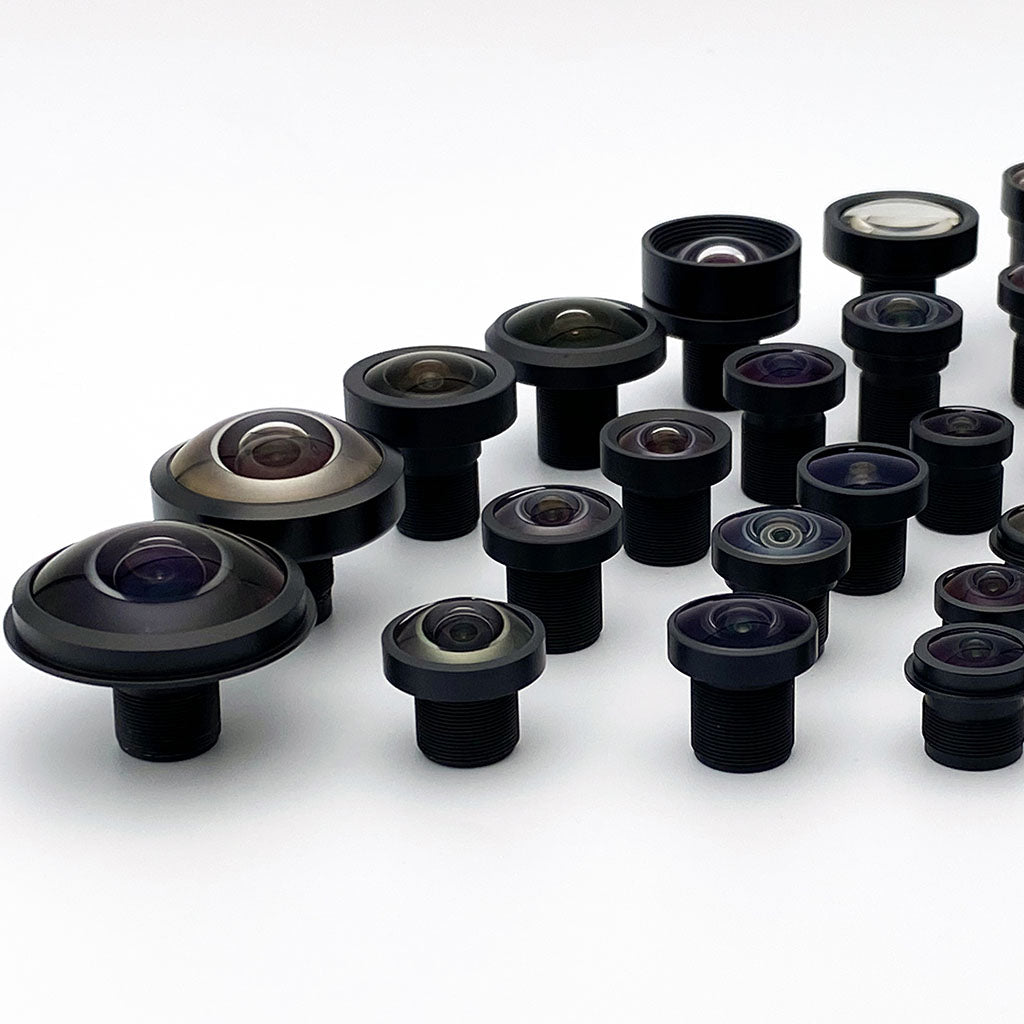Understanding Field of View Calculations
- Field of view depends on focal length and active sensor size
- HFOV/VFOV/DFOV use the formula: 2×arctan(dimension/(2×f)) for rectilinear lenses
- Wide-angle lenses require distortion correction for accurate FOV
- Scene width at distance: Width ≈ 2×WD×tan(HFOV/2)
- This calculator uses a non-standard but practical distortion model for real lenses
The basic field of view calculation assumes an ideal pinhole camera model. For standard lenses with minimal distortion, the formula FOV = 2×arctan(sensor_size/(2×focal_length)) provides accurate results. However, real wide-angle and fisheye lenses deviate significantly from this model at the image edges.
Example FOV Calculations
- 1/2.3" sensor (6.3×4.7mm), 2.8mm lens: HFOV ≈ 103.8°, scene width ≈ 2.10m at 1m distance
- 1/2.3" sensor (6.3×4.7mm), 6mm lens: HFOV ≈ 57.6°, scene width ≈ 1.08m at 1m distance
- 2/3" sensor (8.8×6.6mm), 12mm lens: HFOV ≈ 40.5°, scene width ≈ 0.73m at 1m distance
Note: These calculations assume minimal distortion. Real lenses may differ by 10-25% at wide angles.
Basic FOV Formula
- Assumes perfect pinhole projection
- Accurate for telephoto lenses
- Underestimates wide-angle coverage
- No distortion correction
This FOV Calculator
- Includes polynomial distortion model
- Supports fisheye projections
- Matches real all-glass lens behavior
- Accurate for wide-angle lenses
About the Distortion Model
This field of view calculator uses a non-standard distortion model optimized for real-world all-glass fisheye and wide-angle lenses. While not matching OpenCV's standard coefficients exactly, it provides excellent correlation with measured FOV from actual machine vision lenses. For best results, use the distortion coefficients provided with our M12 lenses with characterized distortion data.
Four Key Parameters for FOV
1) Focal Length
The effective focal length (EFL) determines the angular field of view. Shorter focal lengths provide wider coverage, while longer focal lengths narrow the field of view but increase magnification. Use the actual EFL, not the back focal length (BFL) which only describes the physical distance from the last lens element to the sensor.
2) Sensor Dimensions
Use the active sensor area from your camera datasheet, not the nominal format size. A "1/2.3 inch" sensor actually measures about 6.3×4.7mm active area. The field of view calculator needs these precise dimensions for accurate results.
Common Sensor Formats
Sensor format names are historical conventions that don't match physical dimensions:
- 1/2.3": 6.17 × 4.55mm (7.66mm diagonal)
- 1/1.8": 7.18 × 5.32mm (8.93mm diagonal)
- 2/3": 8.8 × 6.6mm (11mm diagonal)
- 1": 13.2 × 8.8mm (15.86mm diagonal)
For machine vision cameras, always verify the exact active area in the sensor specification.
3) Lens Coverage
The lens image circle must exceed your sensor diagonal to avoid dark corners (vignetting). Most M12 mount holders support up to 12mm diameter image circles. Verify coverage when using large sensors or extreme wide-angle lenses.
4) Distortion and Projection
Barrel distortion increases the effective field of view by compressing more scene content at the image edges. Fisheye lenses use specific mathematical projections (equidistant, stereographic, orthographic) that dramatically alter the FOV compared to standard rectilinear lenses. This calculator supports multiple projection models to match your lens type.
Selecting the Right Focal Length
To determine the required focal length for your application, rearrange the formula: focal_length = sensor_width / (2 × tan(HFOV/2)). For example, to achieve 60° horizontal FOV on a 6.3mm wide sensor, you need approximately 5.5mm focal length.
Remember that depth of field changes with focal length. Shorter focal lengths provide greater depth of field at the same f-number, making them ideal when you need both wide coverage and extended focus range. Browse our M12 lenses or C-mount lenses sorted by focal length.
Common FOV Calculation Mistakes
Confusing Total FOV with Angular Resolution
The field of view tells you the total angular coverage, while angular resolution (IFOV) tells you the angle per pixel. IFOV = FOV / pixel_count. For a 90° FOV across 1920 pixels, each pixel covers 0.047° or about 2.8 arcminutes. This determines the smallest resolvable detail at a given distance.
In low-distortion rectilinear lenses, angular resolution varies across the image. Edge pixels cover more angular area than center pixels due to the projection geometry. A pixel at 30° off-axis represents approximately 33% more angular area than a central pixel, affecting detection algorithms and measurement accuracy.
Using Wrong Working Distance Reference
Working distance can be measured from the lens front, the mount flange, or the entrance pupil. For FOV calculations, use the distance from the entrance pupil (approximately at the lens center for simple lenses). For mechanical clearance, use the distance from the front lens element. This difference can be 20-50mm in longer focal length lenses.
⚠️ Fisheye Lens Specifications
Manufacturers specify fisheye FOV inconsistently. Some quote diagonal coverage at the full image circle, others provide horizontal FOV on a specific sensor. Always verify: (1) which dimension is specified, (2) the projection type (equidistant, stereographic, etc.), and (3) the actual coverage on your sensor format. Our FOV calculator helps you verify manufacturer claims with real measurements.
Using FOV Results
Wide Coverage
- 150-190° diagonal
- 1.7-2.1mm fisheye
- High distortion
Standard View
- 50-70° horizontal
- 6-8mm lens
- Low distortion
Telephoto
- 10-30° horizontal
- 16-50mm lens
- Minimal distortion
OpenCV Camera Calibration
For computer vision applications, the OpenCV camera calibration functions can determine your actual lens parameters from calibration images. The standard model uses five distortion coefficients (k₁, k₂, p₁, p₂, k₃) for radial and tangential distortion.
The OpenCV fisheye module implements the Kannala-Brandt model with four coefficients, optimized for lenses with FOV exceeding 150°. Note that undistorting a fisheye image to rectilinear projection significantly reduces the usable field of view—a 180° fisheye typically yields only 100° of usable rectilinear coverage.
Practical Tip
Use this field of view calculator for initial lens selection and system design. Once you have your hardware, perform a calibration with checkerboard patterns to determine exact parameters for your computer vision algorithms. The calculator's predictions should match your calibrated values within 5% for quality lenses.

